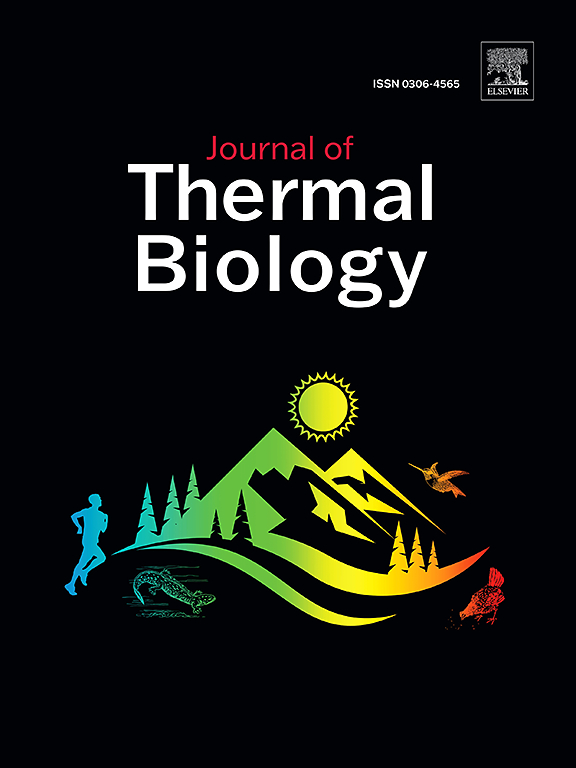Effect of egg incubator temperature on sex differentiation in Korat chickens
IF 2.9
2区 生物学
Q2 BIOLOGY
引用次数: 0
Abstract
The effect of incubator temperature on sex differentiation in Korat chickens was investigated. The experiments were divided into two sets: temperature applied throughout the entire incubation period and temperature applied during certain periods (days 3–6 of incubation) by either increasing above the standard or decreasing below the standard temperature. In each experiment, 300 Korat chicken eggs were separated into three groups of 5 repetitions, with 20 eggs in each group. This was done using a completely randomized design for each experiment: a group using a temperature below the standard for incubation (36.0 °C), a group using the standard incubation temperature (37.7 °C), and a group using a temperature above the standard for incubation (38.0 °C). W chromosomes were detected at hatch; histology examined reproductive structures after 35 days. Increasing the temperature to 38.0 °C throughout the entire incubation period resulted in no significant difference in hatching rates compared to the standard temperature (P > 0.05). Raising the temperature to 38.0 °C throughout the entire incubation and during certain periods resulted in changes in the reproductive structure of chickens, leading to a mismatch between chromosomal and gonadal sex, observed at 9.7% and 5.9% of individuals with W chromosomes possessed testes, indicating a mismatch between chromosomal and gonadal sex. However, decreasing the temperature to 36.0 °C throughout the incubation period resulted in lower hatching rates compared to the standard temperature (P < 0.05). Incubating eggs at 36.0 °C for specific periods resulted in 19.4% of genetic males developing ovaries instead of testes. The presence of ovaries in individuals without W chromosomes indicated this mismatch. The results of this study provide evidence that temperature plays a role in sex differentiation in Korat chickens, as demonstrated by the detection of W chromosomes and histological studies of testes and ovaries. Moreover, this study presents the first evidence in broilers that temperature can affect sex differentiation.
孵蛋器温度对柯拉特鸡性别分化的影响
研究了孵化温度对柯拉特鸡性别分化的影响。实验分为两组:在整个孵化期使用的温度,以及在特定时期(孵化第 3-6 天)使用的温度,即高于标准温度或低于标准温度。在每个实验中,300 枚柯拉特鸡蛋被分成三组,每组 20 枚,重复 5 次。每个实验采用完全随机设计:使用低于标准孵化温度(36.0 °C)的一组,使用标准孵化温度(37.7 °C)的一组,以及使用高于标准孵化温度(38.0 °C)的一组。孵化时检测到 W 染色体;35 天后组织学检查生殖结构。在整个孵化期将温度升至 38.0 °C,孵化率与标准温度相比无显著差异(P > 0.05)。在整个孵化期和某些时期将温度升至 38.0 °C,会导致鸡的生殖结构发生变化,导致染色体性别和性腺性别不匹配,观察到 9.7% 和 5.9% 的 W 染色体个体拥有睾丸,表明染色体性别和性腺性别不匹配。然而,在整个孵化期将温度降至 36.0 °C,孵化率比标准温度低(P < 0.05)。将卵在36.0 °C的温度下孵化一段时间后,19.4%的遗传雄性个体出现卵巢而不是睾丸。没有 W 染色体的个体出现卵巢表明了这种不匹配。这项研究的结果提供了证据,证明温度在科拉特鸡的性别分化中起作用,W 染色体的检测以及睾丸和卵巢的组织学研究都证明了这一点。此外,这项研究还首次证明温度会影响肉鸡的性别分化。
本文章由计算机程序翻译,如有差异,请以英文原文为准。
求助全文
约1分钟内获得全文
求助全文
来源期刊

Journal of thermal biology
生物-动物学
CiteScore
5.30
自引率
7.40%
发文量
196
审稿时长
14.5 weeks
期刊介绍:
The Journal of Thermal Biology publishes articles that advance our knowledge on the ways and mechanisms through which temperature affects man and animals. This includes studies of their responses to these effects and on the ecological consequences. Directly relevant to this theme are:
• The mechanisms of thermal limitation, heat and cold injury, and the resistance of organisms to extremes of temperature
• The mechanisms involved in acclimation, acclimatization and evolutionary adaptation to temperature
• Mechanisms underlying the patterns of hibernation, torpor, dormancy, aestivation and diapause
• Effects of temperature on reproduction and development, growth, ageing and life-span
• Studies on modelling heat transfer between organisms and their environment
• The contributions of temperature to effects of climate change on animal species and man
• Studies of conservation biology and physiology related to temperature
• Behavioural and physiological regulation of body temperature including its pathophysiology and fever
• Medical applications of hypo- and hyperthermia
Article types:
• Original articles
• Review articles
 求助内容:
求助内容: 应助结果提醒方式:
应助结果提醒方式:


